Deep Graves (which I sometimes write as DEEP GRAVES), is the working title of my RPG Maker 2003 game, which I’ve been developing for about a year, now.
This post will serve as a proper introduction to the project, since my previous post was more of a general introduction to the engine I’m using (RPG Maker 2003).
Please note that everything in this post is subject to change. All things considered, I’m still in the early stages of development, and this is a very chaotic time for development.
Story elements, visual elements, and level design, all change frequently, suddenly, and drastically.
General Introductions
If, somehow, you’re already interested in following the release of my game, and don’t need to be convinced by this post, here is a link to my rpgmaker.net profile.
You can expect to see the game uploaded there (for free) once it’s complete.
The Name
Like I said at the start of this post, “Deep Graves” is the working title for my game.
Structurally, the name was inspired by the paired monosyllabic arrangement of the words “Dark Souls,” a video game series that has been a consistent source of inspiration throughout my artistic journey – especially as a game developer.
Original Game Concept
Initially, the title was based upon my original game concept, which followed the journey of a “Grave Digger,” as they traversed a set of catacombs whose depth was ever increasing. Hence, they traveled through “Deep Graves.”
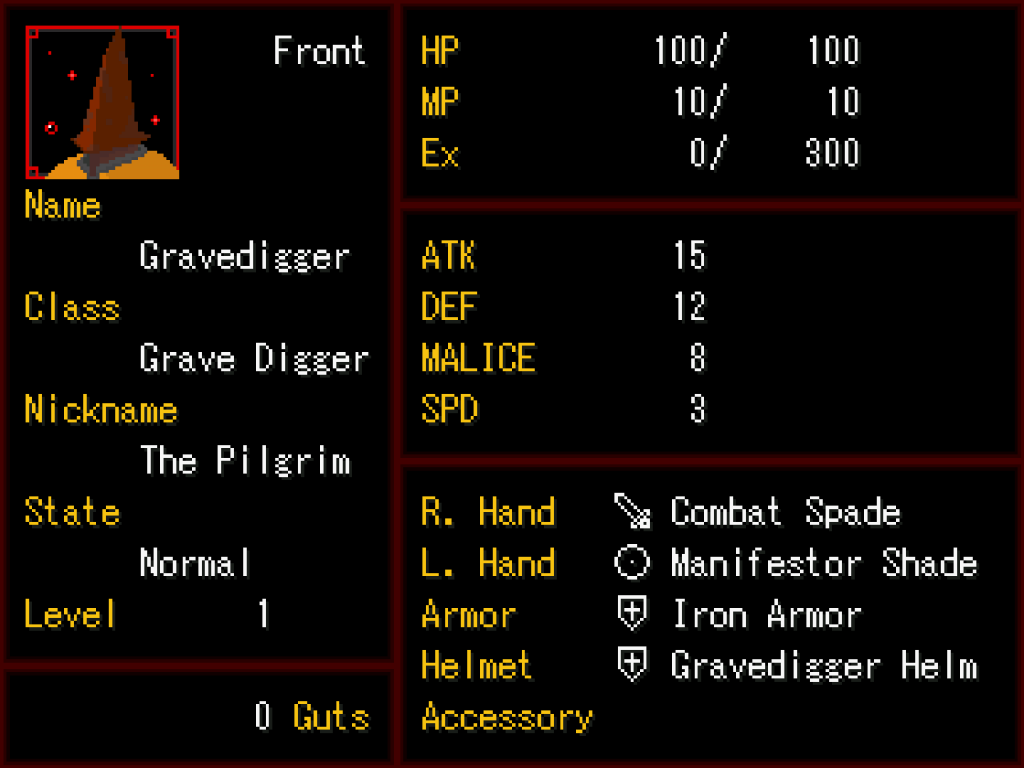
a screenshot of the Gravedigger‘s status screen.
the Gravedigger is one of the playable characters in Deep Graves, and serves as the main character of the game.
Although elements of this original concept have persisted throughout the development process – namely the Gravedigger, who remains the main character – very few of these design elements are present in the game’s current state.
The title, for example, is much less literal, now.
Simply put, I came to realize that designing underground environments was creatively restricting. To be fair, there’s a lot you can do with underground environments if you’re creative enough, but I found that crafting an interesting atmosphere was more effort than it was worth.
The Story
This is, quite frankly, not an area of the game I can discuss in-depth. There’s a couple reasons for this.
For one, like I said in the introduction to this post, the game is still far from complete.
The lore (history, and events preceding the gameplay experience) and plot (the part of the game players will experience, i.e. the ‘storyline’) are far from complete, and much like other areas of the game’s design, subject to change.
I’m not especially comfortable talking about elements of the story which are incomplete. Much of this game’s story is also very personal to me, and I’m not ready to share it, just yet.

a link to the full (3 page) excerpt shown here can be found at the bottom of this section
The more important reason, however, is the fact that I want to avoid spoiling elements of my story before anyone has had a chance to play the game, and experience it themselves.
One of my design goals is to deliver my story through gameplay, so giving away important story elements would, aside from being anticlimactic, defeat the purpose of my game’s design.
If you’re really that interested in reading some of what I’ve written, I’ve provided a link below to a Google Doc containing a very small portion of the foundational lore and worldbuilding elements.
Engine and Genre
As discussed in my previous post, Deep Graves is a JRPG developed in RPG Maker 2003.
Now, my use of the term JRPG may cause some confusion, since the acronym technically stands for “Japanese Role Playing Game.” As I’m sure most of you know by now, I am not Japanese.
To clarify, I use this term to describe traditional turn-based RPGs, visually comparable to the classic Final Fantasy games – generally Final Fantasy 1 – 6.
“Traditional” is relative to video games, in this case. In a broader scope, I’d argue that a true traditional RPG would be something like Dungeons & Dragons.
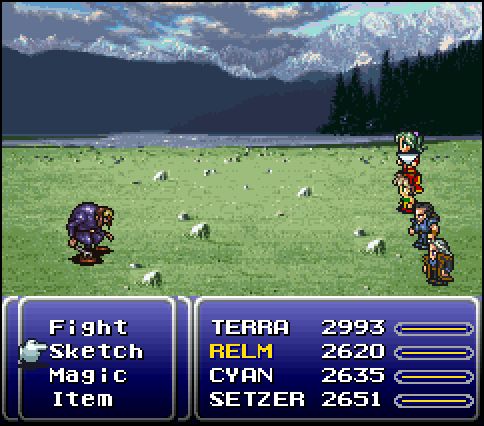
a screenshot of Final Fantasy 6‘s battle screen (Final Fantasy VI).
This use of the JRPG acronym may not be perfectly accurate, but I find that “JRPG” is much easier on the eyes, and easier to say than “TBRPG,” which is an acronym that I’ve never seen used in conversation, and may be confused with “Text-Based RPG.”
Plus, I’m not the only person who defines the JRPG genre so broadly.
For all intents and purposes, the term JRPG refers to turn-based role playing games whose gameplay styles could be considered comparable to classic, traditional RPG video games like Dragon Quest, and the Final Fantasy series.
“JRPGs are Boring”
the first 3 seconds of this videogamedunkey video says it all
This is a relatively common sentiment among gamers, and it’s one that I actually agree with, in many cases.
My Criticisms of the Genre
Unfortunately, many of the conventions of the JRPG genre have tainted perceptions of the genre as a whole. Like I said, I’ve my own criticisms of the genre, so I figured I’d briefly list a few of them here.
“Tell, Don’t Show”
To be perfectly fair, this is not a problem unique to the JRPG genre.
That said, JRPGs often put a great deal of emphasis on dialogue, which, aside from being mind-numbingly boring in some cases, can lead to the mistake of talking about things, rather than showing them to the player through gameplay.
This can evolve into one of my most deadly ‘gaming sins,’ something I (and many others) refer to as, “Win in the Fight, Lose in the Cutscene.”
as seen in this clip, videogamedunkey defeats Mòrag, only for them to defeat his character in the cutscene after the boss fight.
The same thing happens at 4:31.
Obviously, this is the dumbest thing ever.
Again, this is not a problem unique to JRPGs, but it relates closely to the concept of “Tell, Don’t Show,” where, rather than showing you how tough a character is – by making their fight mechanically challenging and interesting – they opt to just talk about it, instead.
Repetitive, Unsatisfying Gameplay
By virtue of their turn-based gameplay, JRPGs require a bit of patience.
That is, you must wait for your turn to finish once you’ve selected actions for your party members, and you must wait for the enemy’s turn to finish as well.
If your combat isn’t engaging, this can make battles monotonous at best, and agonizingly boring at worst.
It is for this reason that I’ve yet to finish OFF, a game I take a great deal of inspiration from. While I love the atmosphere, aesthetic, and visual design of OFF (along with its excellent soundtrack), I.. strongly dislike its combat.
The combat of OFF isn’t satisfying, and while the visual design and dialogue of enemies is excellent, the battle animations themselves are fairly lackluster and rarely distinct from one another.
Many skills share the exact same animation, despite having different effects and damage values. This makes picking between them less interesting, since the (visual) result is the same, regardless of which skill you choose.
in this clip, I use 3 different skills, with different damage types.
all of them use the same animation (including sound effects).
This leads to attacks lacking impact, and fights massively overstaying their welcome.
Plus, unlike Space Funeral, where combat is rare and fights are very short, combat is a fairly prominent part of OFF‘s gameplay loop – that is, you’ll be experiencing a lot of it.
Unintuitive, Obtuse Design
However, OFF‘s biggest problem, in my opinion, is its misuse of unique and novel character designs and elemental damage types.
OFF is an unusual game, and this ‘weirdness’ extends to the design of its combat. Enemies in OFF have strange, obtuse attack types and weaknesses. This includes damage types like Smoke, Plastic, Metal, and Meat.
On its own, I actually like this idea a lot. Most JRPGs use elements like Shock, Fire, Ice, etc. These are overused, in my opinion, so I appreciate OFF‘s attempt to implement unique elements and damage types.
even with knowledge of OFF‘s element types, I never would have been able to guess the weaknesses of these enemies, based on their appearance.
However, these elements aren’t as intuitive as things like electricity and fire.
To make matters more confusing, OFF‘s enemies lack a strong sense of visual consistency, in terms of their relationship to their weaknesses.
This makes it practically impossible to learn the weaknesses of each enemy type. In most cases, you’re forced to either commit them to memory, or guess.
Neither one of these options is very interesting, and it makes combat uninteresting.
Just to be perfectly clear, I really like OFF. Still, I am not blinded to its flaws. It is a great game, but it is not perfect.
Try as I might, my game will not be perfect either.
My Game Design Goals
I have other critiques of the JRPG genre, but if I discuss all of them in-depth, I’ll be here all day – so let’s move on.
Attempting to Innovate
There are a LOT of really great games made in RPG Maker. OFF, Space Funeral, Lisa: The Painful, OneShot, Yume Nikki, and many more. The RPG Maker community is still very active, and full of creative developers.
However, all of the games I’ve highlighted above focus primarily, or entirely on exploration and puzzle-solving as their primary mechanics.
Of course, there’s nothing wrong with that. All of the games listed above are great, and well worth playing.
But, like I said in my previous post, I love JRPGs, and much like thecatamites, I feel as though it’s a relatively unexplored genre, creatively speaking.
Generally, if an RPG Maker game focuses heavily on combat, it will probably be somewhat comparable to Final Fantasy, and will often utilize many of the conventions and design elements of a traditional, high-fantasy RPG game.
With that in mind, I wanted to try and tap into something unique with my game – a JRPG with a unique setting, appealing visuals, dynamic battle animations, and (perhaps most importantly) interesting combat.
Interesting, Exciting Combat
Taking inspiration from ranmaster27, whose work I highlighted in my previous post, I want to make the combat of Deep Graves visually stimulating, and mechanically rewarding.
keep in mind that these animations are subject to change.
I’m planning on redoing them eventually.
Part of making combat stimulating and rewarding requires maintaining the player’s interest and attention. This will be done in part through battle animations, and (perhaps most importantly) challenge.
By making its combat difficult, Deep Graves should demand the player’s attention – since the consequence of losing interest will be defeat.
Non-Traditional Designs
Taking inspiration from Space Funeral and OFF, I’d like to break some of the typical character and enemy design conventions of the JRPG genre.
I love Final Fantasy, but I think thecatamites was right to criticize the restrictive nature of the high-fantasy setting.
In combat, I plan on implementing similarly unusual attack types and weaknesses, but with an important caveat – I intend to make these weaknesses intuitive.
Intuitive Design
By introducing enemy types, along with their strengths/weaknesses gradually, I’ll (hopefully) avoid overwhelming players with new information.
Instead, players will gradually learn the rules of Deep Graves through experience, and use their intuition to succeed in combat.
as suggested by its name, this Slime enemy is made of “the Source,” a golden liquid found throughout Deep Graves.
because of this, it is resistant to attacks of the Source element.
In order to make enemy strengths and weaknesses intuitive, I plan on creating consistent visual designs throughout each area.
Enemies in different areas will appear visually distinct from one another. Using their knowledge of an enemy’s origin, players should be able to determine its strengths and weaknesses.
As seen in the above screenshot, I will also be implementing a ‘scanning’ ability unique to the Gravedigger character, a la OFF‘s “Wide Angle” ability. This will allow players to scan and receive information about the enemies they’re fighting – at the cost of a turn.
If done correctly, the choice of scanning should come with its own risks and reward. Do you spend a turn scanning for more certain weaknesses, or use your intuition to make an educated guess?
Delivering Story through Gameplay
I take a great deal of inspiration from Hyper Light Drifter and the Soulsborne series in this department.

what do the environment and decorations outside of a home tell you about the people that once lived there?
how can the story be delivered through the visuals of a game?
Video games are an artistic medium with the unique opportunity to deliver aspects of their world and story through gameplay.
Despite this, many games (mostly AAA titles, in my experience) relegate these elements exclusively to dialogue and cutscenes.
In my opinion, this is lazy.
With that in mind, I hope to keep dialogue relatively sparse and esoteric, to encourage interpretation, and keep players guessing.
I’ll also try to avoid overwhelming players with walls of dialogue, and make most of it optional. If players want to learn more about the world, they can. If not, they can avoid these extra conversations.
Conclusions
I love the JRPG genre, but I think its conventions are overused, and its potential is somewhat unexplored.
Through Deep Graves, I hope to craft an immersive experience that rewards player intuition with visually stimulating, carefully designed combat, and a unique world to explore.
I hope to complete this project before (or shortly after) I graduate from college, and I plan on releasing Deep Graves for free once it’s finished.
Here’s another link to my rpgmaker.net profile, where you can expect to find the game, once it’s complete.
And as always, thanks for reading.
Sources
- Final Fantasy VI: Sketch Glitch. (2011, September 23). [Screenshot]. LP Archive. https://lparchive.org/Breaking-Final-Fantasy-VI/Update%2008
- videogamedunkey. (2017, December 14). Xenoblade 2 : JRPG Chronicles [Video]. YouTube. https://www.youtube.com/watch?v=fiVZMxf4E2Q&feature=youtu.be
Disclaimer
All information in these posts is my own words, unless explicitly stated otherwise. None of this information is quoted, nor paraphrased, unless explicitly stated otherwise. Any similarities between my own words, and the informative sources/hyperlinks provided is purely coincidental, unless explicitly stated otherwise.
In any case where I am using someone else’s words (or imagery), the source will be cited internally, with a link to that source provided either within the internal citation, at the end of the post under “Sources,” or both.

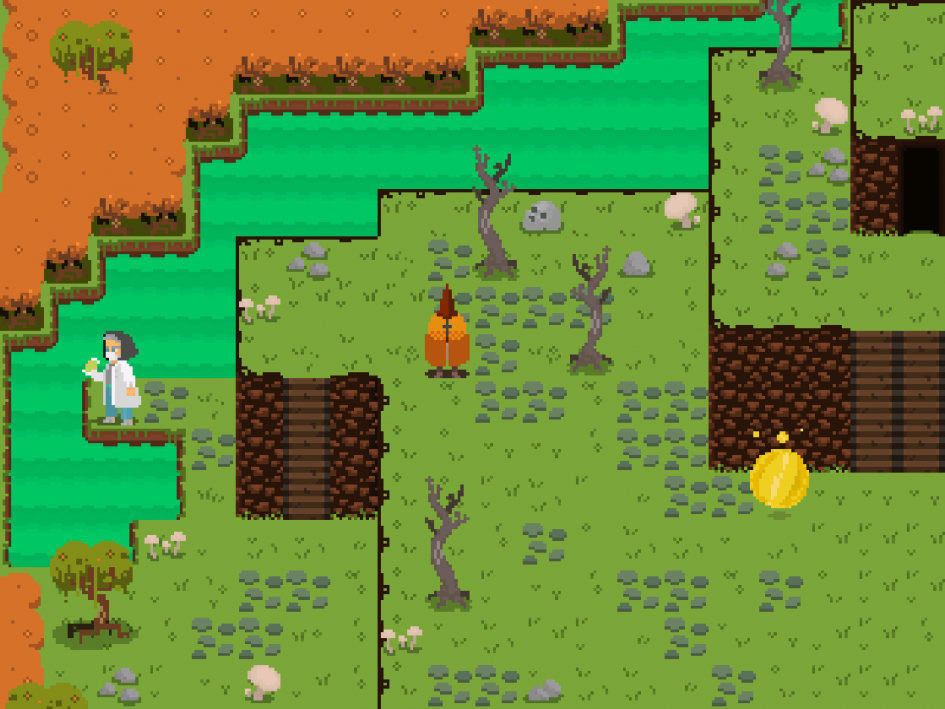
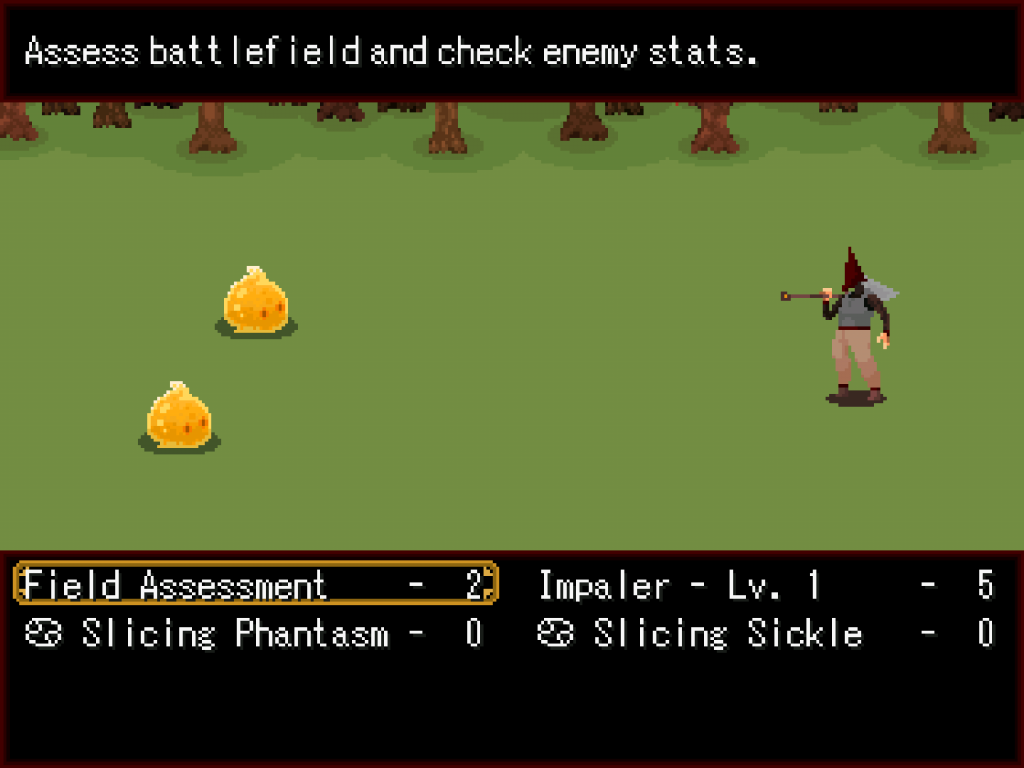
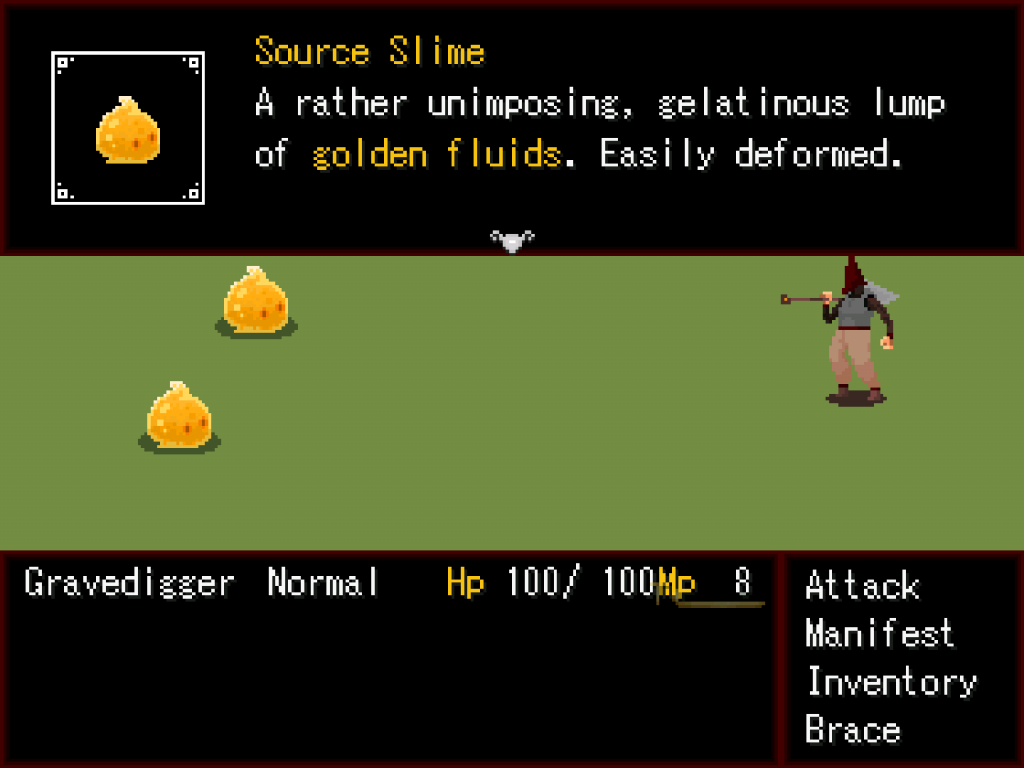
April 3, 2021 at 5:47 am
You are very critical of RPG games, and I think that is benefiting you a lot. So you can make a unique RPG game with an amazing experience from start to finish.
Great job. I think you should continue this blog after the class ends because you have a lot to say and show. As well as document the progress of your game.
April 3, 2021 at 7:36 pm
Your words of encouragement mean a lot, man. Thank you.
I have been considering continuing this blog after the class ends. At the very least, I’ll be making sure the blog doesn’t disappear alongside my UWW email/account.
That said, I’m not sure how active I’ll be on this blog throughout the game’s development.
For one, I’m hesitant to share details related to my game, since I want to avoid spoiling the experience for anyone interested in playing it once it’s done.
For another, it takes me a while to write these blog posts – this one took around 4 hours. I think that time would be better spent working on Deep Graves, as opposed to just talking about it.
In any case, I appreciate your support, and interest in seeing what I have to say. Maybe I’ll make an effort to update this blog on occasion, once the semester is over.
April 5, 2021 at 4:07 am
I agree with Mohammed, you should definitely keep going with this blog once our class is over! I know it may be hard at times to keep a constant update on your game, but it would be interesting to see where your game is in the next upcoming months.
Personally, I love to play RPGs but I have no experience with the creation of them, so I enjoy seeing and reading about your process of creating your own game. You put a lot into your work and your game and it amazes me! Even though you haven’t give us a full in-depth story line, it still interests me and I can’t wait to learn more about it in the future. Overall, I really enjoy your posts about game development and I can’t wait to read more!
April 5, 2021 at 7:29 am
Again, thank you. Your kind words mean a lot.
I’d definitely love to talk more about my game, but I want to avoid oversharing, so I have to be careful. Like I said in the post, I want to avoid spoiling elements of gameplay, and the story – I want to release the game such that most players will play it more or less blind, for the first time.
That said, I think there are other aspects of the content that I could share, such as progress on art assets and animations. Certain visual elements aren’t necessarily spoilers, so I think I could get away with sharing some of those things.
April 6, 2021 at 7:26 pm
Hey! Great to finally see the game you’re working on. So far, I really like what I’m seeing from it. The art direction is great, as I’m a sucker for pixel art/sprite art. The world of your game feels mysterious and exciting. As far as the criticisms for JRPGs go, I can see where you’re coming from. There are a good chunk of them that don’t do anything to innovate and just copy-paste from other games.
I’m developing a game too, but it is definitely still very early on in the conceptual stages. The main games I take inspiration from are Fire Emblem, Kingdom Hearts, and somewhat Monster Hunter.
April 6, 2021 at 7:37 pm
Thank you! I’m glad you enjoy the (admittedly small) snippet of content I was able to show for this post. I’ve been too busy to work on the game much lately, but the motivation to work on it has been steadily building.
Hopefully I’ll be able to continue writing/developing the story this week.
JRPGs are definitely an interesting, but underused genre. I love Final Fantasy, but there’s a lot of untapped creative potential in the genre. Persona 5 is a good example of a non-traditional setting done well in a JRPG.
And hey, great to hear you’re developing a game as well. I think Deep Graves spent almost exactly 2 full years in the earliest conceptual stages. I’m still in the early stages of development, but I’ve begun to pin down more concrete ideas related to the gameplay and story.
I’m looking forward to being more or less done with the story, so I can start creating visual assets without having to worry about things changing quite as drastically.
April 6, 2021 at 10:46 pm
Hey! This is actually awesome work, I love the bit style and appreciate a lot of the mechanics you’ve mentioned towards friendly player UI.
April 7, 2021 at 12:17 am
Thanks man, I really appreciate it.
Yeah, I’m hoping to make this a challenging JRPG that’s playable by all people, whether they experienced with the genre (or gaming in general) or not.
I think good game design makes virtually any game playable when done correctly, regardless of individual player experience.
April 7, 2021 at 2:35 pm
This is another great post- your blog is definitely one of my favorites and I make sure to visit every week because your posts are so interesting!
April 7, 2021 at 7:20 pm
Thanks so much! I definitely end up spending a lot more time on these blog posts than I initially expect, so I’m glad to hear the content is worth the effort.
July 21, 2021 at 3:01 am
such us a good games, thanks for sharing
June 7, 2022 at 8:22 am
The information you shared is very helpful, thank you for sharing.
February 14, 2023 at 10:06 am
great concept and really cool art man
keep up the good work
March 8, 2023 at 5:55 am
Good job man, I’ll give it a shot
August 21, 2023 at 7:11 am
Thanks for the amazing information admin. its very useful to all.
August 21, 2023 at 7:13 am
Wow, it’s a great article, I expect more posts like this.
November 10, 2023 at 1:50 am
It looks so great, thanks for sharing
February 7, 2024 at 12:11 pm
Your post is quite clear and i can tell you know a lot about the subject
April 1, 2024 at 7:00 am
PelisPlus is your go-to destination for an extensive collection of movies and TV shows, offering a diverse range of genres to suit every taste. Stream your favorite content effortlessly and enjoy high-quality viewing experiences anytime, anywhere. Discover new releases, timeless classics, and binge-worthy series all in one convenient platform. Join PelisPlus today and elevate your entertainment experience to new heights.